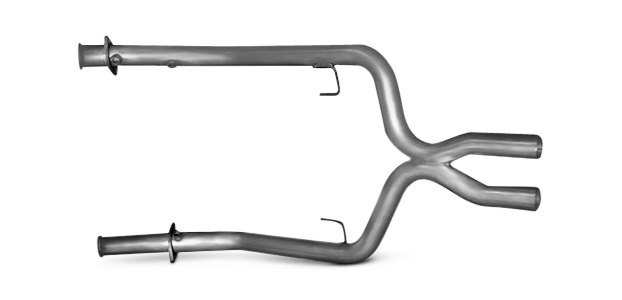You may be wondering why so many aftermarket performance exhaust system manufacturers are offering dual exhaust systems connected by "H-pipe" or "X-pipe" sections. After all, aren't two separate pipes, or so-called "true duals", the best for performance? The answer is no, but to understand why we have to examine how a typical internal combustion engine works.
In short, H- and X-pipe exhaust sections benefit V6 and V8 engines because they connect separate pipes coming from the two different exhaust banks found on those engines. Inline engines where all the cylinders are in a row gain nothing, because they have only one exhaust bank. When it comes to bang for the buck, H- and X-pipe sections are so effective that automakers have used them on select high-performance models for decades. But most importantly, these sections can easily be added to an existing dual exhaust system without much, if any, modifications.
The consensus opinion among exhaust flow experts is that any V8 engine will benefit from an H-pipe or X-pipe section mounted on a dual exhaust system. Others feel X-pipes are better suited to free-revving overhead cam V6s and V8s, while H-pipes are a natural fit for high-torque big-block V8 engines that make their power lower on the rpms scale.


If you hold your hand behind a tailpipe, the exhaust flow feels like a continuous stream, but it's actually a series of pulses, each of which is created every time one cylinder's exhaust valve opens in the firing order. On a typical V8 engine, one cylinder on each bank fires within 90 degrees of crankshaft rotation of another cylinder on the same bank. The resulting exhaust pulses are very close together as they travel through the exhaust system and on some vehicles they create a popping noise.
H-Pipe Section
H-pipe sections were first installed to quiet this exhaust noise. When the two close firing cylinders are exhausting on one bank, there is nothing happening in the other bank, so connecting both pipes effectively enlarged the exhaust system, allowing these exhaust pulses to exit through both sides of the system. It was found that, with the addition of an H-pipe, exhaust noise could be reduced by as much as 2 decibels.
Adding an H-pipe section also increases power. Even when headers are installed, these close firing cylinders are competing for space in the exhaust pipe after the collector, which creates backpressure and reduces power. Connecting the exhaust pipes allows pressure to escape to the other side of the system, with a resulting gain in low-end and mid-range torque. However, the effectiveness of an H-pipe section decreases somewhat at higher rpm. The increased exhaust gas velocity at high rpm causes most of the exhaust to take the path of least resistance and continue down the exhaust pipe, rather than make the turn into the H-pipe.
When it comes to H-pipe sections, we've got the BBK H-Pipe and MBRP H-Pipe, both made from aluminized steel (see our description of this type of steel in a paragraph further below). The Kooks stainless steel H-Pipe is offered in street-legal and off-road-only configurations, and is designed to work with many late-model Mustangs. Likewise, PaceSetter’s Off-Road Pipe Kit is designed for non-street legal applications. Hyundai Genesis Coupe owners should check out the ARK Performance stainless steel Polished H-Pipe.
X-Pipe Section
The solution to some of the shortcomings of H-Pipe layouts is the X-pipe design. With an X-pipe section, the two sides of the exhaust system are merged rather than just connected, allowing the exhaust from each bank to easily flow into both exhaust pipes. The exhaust pressure on both banks is equalized and power is increased at all engine speeds.
As with the H-pipe, an X-pipe also affects the sound of the exhaust. Testing by one exhaust manufacturer indicated an X-pipe equipped system was several decibels quieter than an equivalent H-pipe system. And although sound quality is subjective, many have described the exhaust note from an X-pipe system as higher pitched and smoother than an H-pipe system.

We offer stainless steel X-pipe sections such as Borla's Stainless Steel X-Pipe engineered for catalytic converter setups and Gibson's Crossover X-Pipe (some versions available in aluminized or stainless steel) created to replace stock H-pipe and converters with a non-converter setup, making them legal for off-road use only.
For Ford Mustang enthusiasts, we've got aluminized steel X-pipe sections from BBK. Choose their High-Flow X-Pipe or eXtracter Series Mid-X-Pipe – both of which are available for catalytic convertor or no-cat setups. Kooks makes the Stainless Steel Catted X-Pipe for high-performance models such as the Ford Mustang as well as the Chevy Corvette and Chevy SS.
Aluminized Steel

Reading this article, you’ll notice many of the H- and X-pipe sections we reference are made from “aluminized steel”. This is traditional (not stainless) steel that's been fully coated on all sides with aluminum-silicon alloy. The process produces a strong metallurgical bond between the two metals which gives traditional steel a significant level of corrosion resistance. The underlying steel provides higher strength and rigidity than would be possible with all-aluminum construction, and the aluminum coating allows the whole system to reflect heat away more effectively.
However, while the aluminum coating keeps pit corrosion from occurring in winter climates, aluminized steel can corrode if the aluminum layer is scraped or chipped away by rock hits, scrapes, or other impacts.
Best Spot To Mount X-Pipe / H-Pipe Section
Many ask if the best spot to mount an X-pipe or H-pipe section is up front just behind headers (or exhaust manifold), toward the rear in front of mufflers, somewhere in the middle, or anywhere there's room. Exhaust system experts say the best spot to put your section is generally toward the front of the exhaust system near the transmission.
Old-school racers swear by a crayon trick to find the exact optimum point in the system. What they do is use the crayon to draw a thick, waxy line along the whole length of the exhaust system. After heating up the exhaust system by taking a short drive, an inspection of the system will let you see where the crayon wax stops melting. Whatever spot that may be, that's the optimum place to start your section.
Others say if space is tight or the underbody of your vehicle doesn't allow placement in the optimum spot, mount the X- or H-pipe wherever it's realistically possible. You may lose a slight bit of performance by doing so, but you'll still gain compared to not having a crossover exhaust section at all.

To help guide you through the selection of H- and X-pipe sections we offer, we have set up the corresponding Performance Exhaust Pipes section of our website to provide you with the choices that will fit your vehicle. It's possible to enter specific make, model, and year in drop down boxes before your search to see applicable choices together. If your ride has a V-engine under the hood, you owe it to yourself to discover what a crossover pipe (H-pipe or X-pipe) will do for the sound and performance of your machine.

